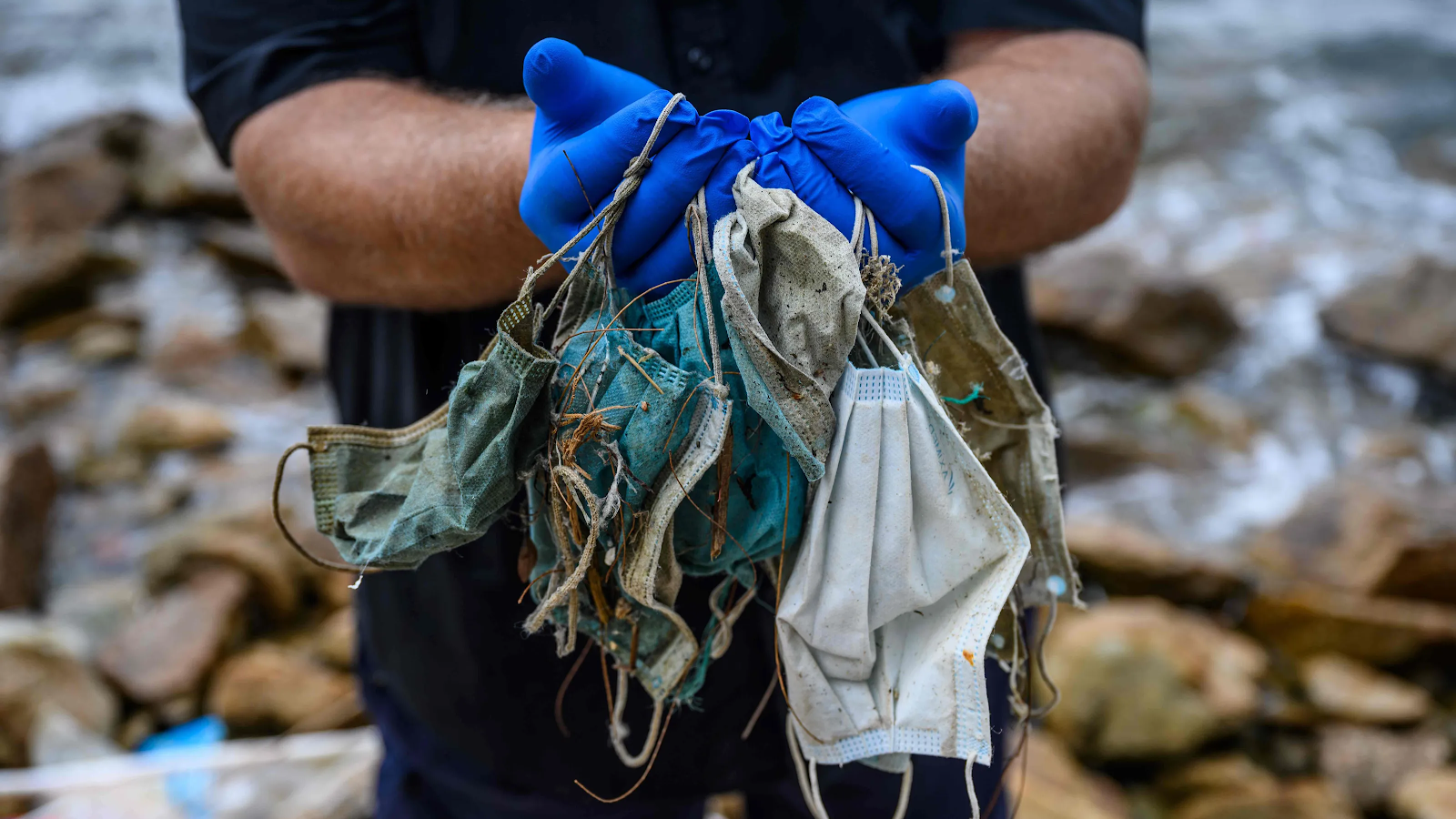
Maribel Perez Wadsworth in a USA Today article writes about disposable masks found littered in the environment. (Photo by USA Today)
By AMBER HOLT – Student contributor
It is without a doubt that the pandemic and the 2020 lockdown drastically affected physical and mental wellbeing, the economy, and so much more around the world. However, one substantial effect that has seemed to frequently fly under the radar is the environmental impact, both good and bad, from the coronavirus pandemic.
Some sources argue that the worldwide lockdown back in March 2020 was beneficial to the environmental health of our world. The stay-at-home order reduced air pollution for a short period of time stemming from transportation and factories. Most notably, the lockdown decreased the amount of carbon dioxide (CO2) and nitrogen dioxide (NO2) emissions.
CO2 is known as a direct greenhouse gas, meaning that it is a gas that traps heat in the atmosphere and substantially contributes to global warming. Greenhouse gases like CO2 are also detrimental to the health of our world’s citizens since smog and air pollution can be partly responsible for respiratory issues. NO2 is known as an indirect greenhouse gas, a slightly less important gas that also contributes to bad environmental and citizen health.
Studies revealed that in New York City, a location heavily impacted by the lockdown, NO2 emissions seemed to decrease, which in turn benefited the environment. However, it was also revealed that the slight decrease in the trends of NO2 emissions didn’t have that much of a long-term effect on the health of the environment.
Another study conducted in China during the COVID-19 outbreak at the beginning of 2020 reported that multiple gases, including CO2 and NO2, were noticeably reduced during the shutdown.
Xiaoqin Shi and Guy P. Brasseur of the Max Planck Institute for Meteorology in Hamburg, Germany, found that “in Wuhan [,China], which was entirely locked down during the coronavirus outbreak, the average tropospheric NO2 column, which was of the order of 3 × 1016 molecules cm−2 during the 10–15 February 2019 period, was reduced to (6–7.5) × 1015 molecules cm−2 during the same period 1 year later.”
The 2020 lockdown seemed to give the environment a break from an excess of greenhouse gases for a brief period of time, but it must be reiterated that the isolation only affected the world’s health on a short-term scale. The graph provided by NASA further demonstrates this point.
Despite the beneficial results, it must also be noted that the COVID-19 pandemic has had numerous negative effects on the environment and its wildlife.
With the increase in demand for personal protective equipment (PPE), the waste of single-use masks and gloves has also increased exponentially. These discarded items have spread out into the environment, causing even more pollution and potentially endangering the local wildlife.
The World Wildlife Fund (WWF) stated that “If only 1 percent of the masks were disposed of incorrectly and perhaps dispersed in nature, this would result in 10 million masks per month in the environment. Considering that the weight of each mask is about 4 grams, this would entail the dispersion of over 40,000 kilograms of plastic in nature, a dangerous scenario that must be diffused.”
Animals can get entangled in the straps of disposable masks, and most masks are not biodegradable, which establishes a situation where both environmental and animal safety are in jeopardy.
It is suggested that in order to combat the influx of single-use PPE in the environment, mask-wearers should utilize reusable masks whenever possible. In situations where using disposable masks is unavoidable, it is recommended for people to cut the straps before disposing of them to help prevent animals from getting entangled.
Another well-known factor that can aid in improving our world is choosing not to litter. Masks are not meant to remain outside, and it is critical to dispose of them properly to protect the health of our environment and wildlife.
The COVID-19 pandemic has certainly brought about a number of changes, both beneficial and adverse, but the positive changes don’t have to be forgotten as conditions improve. By working together and making decisions to reduce the harmful environmental effects of the pandemic, the health of our planet and its residents can be restored over time to a much more desirable state.
Amber Holt is a student at Cranberry High School and a member of Cranberry Chronicles, the school’s journalism/publications class.

A graph of carbon dioxide (CO2) concentration levels shows a slight decrease in the CO2 levels in March 2020, but in the grand perspective, it is not that significant (“Carbon Dioxide Concentration”). (Graph by climate.nasa.gov)
Sources
Canning-Clode, João, et al. “Will COVID-19 Containment and Treatment Measures Drive Shifts in Marine Litter Pollution?” Frontiers, 30 Jul., 2020, www.frontiersin.org. Accessed 9 Mar., 2021.
“Carbon Dioxide Concentration.” NASA, 19 Feb. 2021, climate.nasa.gov. Accessed 9 Mar., 2021.
Cozier, Muriel. “Disposing of PPE responsibly is essential.” SCI – where science meets business, 1 Jul. 2020, www.soci.org. Accessed 9 Mar., 2021.
Environmental group warns of pollution from coronavirus PPE. 9 June 2020. USA Today, Maribel Perez Wadsworth, www.usatoday.com Accessed 9 Mar. 2021.
Satein, Hannah. “Chemical Relationships between Greenhouse Gases and Air Pollutants in Biomass Energy Production.” Beyond Toxics.org, 28 July 2009, www.beyondtoxics.org. Accessed 9 Mar., 2021.
Shi, Xiaoqin, and Guy P. Brasseur. “The Response in Air Quality to the Reduction of Chinese Economic Activities During the COVID‐19 Outbreak.” AGU, 18 May 2020, agupubs.onlinelibrary.wiley.com. Accessed 9 Mar., 2021.
Vets delivered the bird by the RSPCA after it was spotted with its legs tangled in a face mask. Source: South Essex Wildlife Hospital. 1 Sept. 2020. Yahoo! Sports, au.sports.yahoo.com. Accessed 9 Mar., 2021.
Zangari, Shelby, et al. “Air quality changes in New York City during the COVID-19 pandemic.” ScienceDirect, Gan, Jay ed., 25 June 2020, www.sciencedirect.com. Accessed 9 Mar., 2021.


































